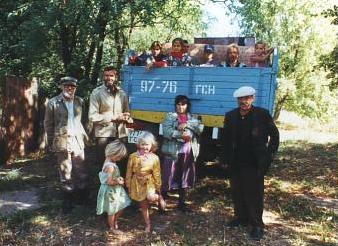|
|

|
Nahja no mura
Nadjas Dorf / Nadya's Village Seiichi Motohashi Japan 1997 Produktion und Weltvertrieb/production company and world sales: Sosna Film Nakano-ku, Higashinakano, 4-4-1-7F, Tokyo, Japan Tel.: (81-3) 32271870, Fax: 32271406 Kamera/cinematography: Masafumi Ichinose Ton/sound: Kikuchi Nobuyuki Schnitt/editor: Sato Makoto Musik/music: Komuro Hitoshi Format: 35mm, 1:1.66, Farbe/colour Länge/running time: 118 Minuten/minutes |
Babylon im Zeughauskino Fr 13.2. 17.00 OmU Kino 7 im Zoo-Palast Mi 18.2. 11.00 OmU Delphi-Filmpalast Mi 18.2. 16.45 OmU Arsenal Do 19.2. 22.30 OmU Akademie der Künste Fr 20.2. 19.30 OmU | |
|
In den frühen Morgenstunden des 26. April 1986 explodierte das Atomkraftwerk Tschernobyl. Kurz nach der Explosion verteilte ein einsetzender starker Wind Radioaktivität über das gesamte Gebiet und verseuchte auch den Landstrich Gomel in Weißrußland. Fast alle der dreihundert dort lebenden Familien wurden gezwungen, ihre Häuser zu verlassen. Nur sechs Familien blieben zurück, weil sie meinten, ''nicht einfach davon laufen zu können''. In der weiten, kontaminierten Ebene Weißrußlands führen sie ihr eigenes, abgeschottetes Leben. Nadja, inzwischen acht Jahre alt, ist nach der Katastrophe geboren. Im Frühling breiten sich grüne Felder vor ihr aus, und im Sommer hilft sie bei der Getreideernte. Danach beginnt der lange, harte Winter. Seiichi Motohashi fuhr 1991 zum ersten Mal nach Tschernobyl. Er suchte sowohl Reaktor 4 des Atomkraftwerks auf wie auch die Krankenhäuser in der verseuchten Region. Seit fünf Jahren fährt er immer wieder zum Ort des Geschehens und fotografiert die Menschen, die sich der Katastrophe mit dem Mut der Verzweiflung entgegenstellen. Da er glaubt, daß ''Film nur aus der engen Beziehung zur Wirklichkeit entstehen kann'', hat er längere Zeit bei ihnen gewohnt und dabei festgestellt, daß sie trotz der immensen Alltagsschwierigkeiten und der radioaktiven Gefahr, der sie ständig ausgesetzt sind, ein erfülltes Leben haben. In Nadjas Dorf hat er es dokumentiert, mit dem scharfen, distanzierten Blick des Fotografen und dem Engagement des Regisseurs für das ungewöhnliche Schicksal der Menschen. Seiichi Motohashi, geb. 1940. Studium der Fotografie an der Jiyu Gakuen-Hochschule. Nahja no mura ist seine erste Filmarbeit. |
In the early morning of 26th April 1986, the Chernobyl nuclear power station exploded. Shortly after the explosion a strong wind set in, spreading radioactivity over the entire region and polluting the land. Almost all the three hundred families who lived in the Gomel area (Belorussia) were forced to leave their homes. Only six families stayed behind, because they thought they ''couldn't simply go away''. On the broad, contaminated White Russian plain they are leading their own isolated life. Nadya, who is now eight years old, was born after the disaster. In spring the green fields spread out before her, and in summer she helps with the grain harvest. Then begins the long hard winter. Seiichi Motohashi went to Chernobyl for the first time in 1991. He visited reactor 4 of the nuclear power station and the hospitals in the contaminated region. For the past five years he has continually revisited the scene of events and photographed the people who confront the catastrophe with the courage of despair. Since he believes that ''film can only emerge from a close relationship to reality'', he has spent an extended period living with them, and has come to the conclusion that they have a fulfilled life, despite the enormous problems of daily existence and the danger of radioactivity they constantly face. He has documented this in Nadya's Village with the sharp, detached eye of a photographer and the commitment of a director to the unusual fate of human beings. |

